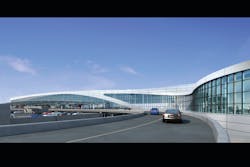Your dream parking garage
Everyone has a "dream" house. Mine has a patio overlooking a freshwater lake, a deep claw foot tub in the bathroom and a double stainless-steel oven in a modern kitchen. Today, airport executives are dreaming of parking garages: with cutting-edge technology, easy-to-find spaces, happy customers and steady revenue streams.
Parking facilities typically are the first or second in line of revenue producers at an airport, a fact that surprises many people, especially the general public, says Frank Flanagan, principal of Sentry Control Systems. He explains while other parking garages empty each night, the same can't be said for airports. For a longer stay at a metropolitan airport, a parking receipt can easily be $100 to $200 per vehicle, and this adds up quickly.
While my current home isn't yet my "dream" home, I've come a long way from my early college days, and parking garages have evolved over the years too. They are no longer sustaining on basic Ramen, but giving passengers (and airport directors) much to be thankful for in terms of efficiency, affordability and of course, the many tiers of technology. Airports realize money spent on a dream parking garage comes with a significant return on investment.
"12 spaces remaining"
A top item on a dream parking garage list is a guidance system, says James E. Maglothin, director of Car Park Management Systems at Walker Parking Consultants. He says five years ago airports were interested in them, but the funding was the issue. "Today, airport competition is a big driver," he says. "More of these projects are being funded. Peer airports see that and obviously want to compete and provide the same level of customer service."
There are a variety of way finding levels an airport can invest in, Maglothin adds. The further from the airport, the information is simpler, but as a driver comes closer, the way finding becomes more detailed. A recent project at San Antonio International Airport is a good example. The parking guidance system directs an arriving driver where to go for each parking need (long-term, hourly, etc.), then how many spaces are available on each level of the garage, and finally, directs to the single, open space. A green or red sensor above each spot lets drivers know further down an aisle where that open one is located.
"It helps them park a lot quicker and reduces emissions on circulating vehicles," says Maglothin. "It also allows an airport to utilize 100 percent of the spaces, whereas in a normal facility a level might be shut down when it's 95 percent full so patrons don't have to drive around for 10 minutes to find a space."
Flanagan says a guidance system is a way to attract customers and deter them away from other parking competitors, as well as maintain accurate numbers on the use of the garage. "It is critical for airports to not make the assumption their parking volumes are going to increase over the next decade," he notes. "They need to make sure they are anticipating what might happen to their volumes and understand the usages of their garages."
Newer technologies make this easier by using heat maps to show when stalls are open, how long they are occupied, etc. Flanagan says the price for technology is coming down, but the improvements it gives to the user experience continues to rise.
Per garage level, a guidance system can cost anywhere from $5,000 to $10,000 depending on the facility, Maglothin says, and notes it is hard to numerically calculate the return on investment as it is intangible.
Again, it boils down to market share and capturing customers' attention from the competition, in and out of the parking garage. He says the faster the person is in the terminal, the more time they have to spend money on concessions and shopping. "They also may be less stressed, more relaxed and have the willingness to ease into some of the other buying opportunities," he adds. A guidance system is a win/win in that dream airport parking garage.
Offer extras
Everyone likes that something extra which makes them feel special and welcome. Airports are catching onto this mentality and bringing a level of service to their customers in ways unheard of before in this industry.
With the competition offering to-terminal shuttles, free water and newspapers, the airports have to find a better way to sell their product's value, Maglothin says. The number one advantage the airport still has over most of the off-site competitors is proximity to the terminal. Premium spaces generally are located the closest, and offer the highest level of technology and places to add perks.
Online reservations and loyalty programs are two of those. Loyalty programs are a big deal for the airlines, but Flanagan says they are being offered for airport parking at only a few facilities. They are catching on, though.
In Atlanta Hartsfield International Airport, a gold parking lot allows members to pay an annual fee, guaranteeing them a pot in a premium location. Also, they are assigned a transponder tag which calculates the duration of their stay in the parking garage and automatically charges the account on file.
With many airports located near interstate tollways, working with the toll agencies has proven to be a good move for airports, such as the Dallas-Fort Worth International Airport. Visitors with current TollTags can use that at the airport, and charge transactions that way. Designated lanes are used for this exit method.
Technology in general is a perk and while smartphone isn't going away anytime soon, it actually is getting "smarter" each year. Flanagan says the 20 to 30 year-old crowd becomes the 30 to 40 year-old crowd in the next decade, and "that group will expect to use their cell phones for everything at an airport, from entering, navigating parking, getting through security as quickly as possible and boarding the plane."
It will also be used in a retail environment, and Flanagan says this crowd expects transactions to be transparent and as easy as online shopping, even in a parking garage. "I think you're going to see more applications of using a smartphone as a mobile wallet, says Maglothin. "It will become a more accepted form of payment."
Get an exit strategy
While guidance systems allow visitors to easily make their way into the airport, the exit is just as important. Passengers are tired, and excited to get home or to their local destination without a fuss.
Maglothin says a guided procedure, fast transactions and clear directions upon exit provide a positive experience for visitors. Most airports still have some level of cashiering, but the industry in general is reducing manual labor with automated machines.
Flanagan says license plate recognition cameras are used widely in the industry to avoid fraud at exits. If a person says they lost their ticket at the exit kiosk, their information will have been stored electronically based on their license plate information. This greatly protects the airport's parking revenue stream, as many people have found ways to pay less.
Another way is by credit card recognition. Instead of giving a paper ticket, a visitor simply swipes their card upon entering and uses the same when leaving. "It provides a much faster transaction than a typical cashier with a ticket, or even a ticket with a credit card," Maglothin adds.
Speaking of credit cards, he says something that will certainly impact parking technologies in the future is the Europay, Mastercard, Visa (EMV) standard that is mandated compliant by October 2015.
Many places in Europe require a pin number to use a credit card, he explains. While in the United States, that is already the process for debit cards, it would be across the board for all card transactions. Airports are concerned with having to install PIN tabs on all exit lane devices, and also shouldering the cost to modify or replace equipment which can't handle the new processes. "And, the software costs on the backend to process these transactions," he adds. "All airports are going to be affected by this."
The balance in getting a dream parking garage comes in the amount of money an airport invests in new technology and the level of technology it can afford. Each airport's dream parking facility will be different depending on buildings, passenger trends and financial ability, but it's without question that a positive experience will attract return visitors.
Maglothin suggests execs look at their parking revenue system, the amenities which an airport offers to visitors and then comparing those to peer airports. "Really judge yourself if you're implementing the best practices because that's what customers ultimately will expect, and you could be putting yourself at risk for revenue losses if you're not meeting the latest standard," he concludes.
About the Author

Jen Bradley
Jen Bradley, owner of Bradley Bylines, is an aviation writer based in East Troy, WI. She may be reached via her website at www.bradleybylines.com.
